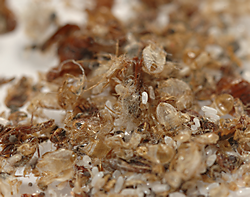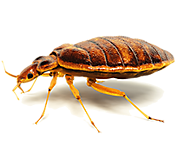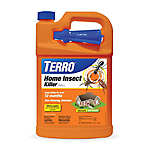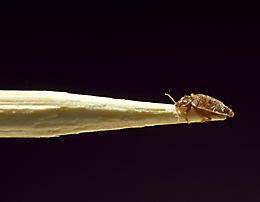BED BUGS
The thought of a bed bug infestation is understandably scary. By learning about how these parasitic bugs live and why bed bug infestations are becoming more commonplace, you can take measures to safeguard your home.
What Are the Signs of Bed Bugs?

Given their small size and tendency to hide in the daytime, bed bugs can be hard to detect. Your most obvious sign of bed bugs will be rashes on your skin after sleeping.
If you want to see them for yourself, look around the suspected infestation area. For beds, look between the mattress and the box spring. Check in the cracks of the bed frame or any object that could harbor them within 8 feet.
You can even catch them in action if you wake up early enough. Bed bugs are nocturnal, and most active between midnight until a little after 4 a.m. Flip on the light any time during this period and begin your search – just be aware that they’re fairly fast moving.
Another sure sign of bed bugs is that they will leave black or dark brown spots on infested surfaces. These spots are actually the dried excrement they expel before going into hiding each night.
Particularly heavy infestations can also be detected by the smell of rotted raspberries in a room. This sickly, sweet smell is a combination of several bed bug activities, including mating pheromones, discarded exoskeletons and their excrement.
How Can I Control Bed Bug Infestations?

As the bed bug problem re-emerged in New York City, a Bed Bug Advisory Board was established in 2009 to help guide residents there. The board’s goal was to provide clear advice on preventing infestations in homes, businesses and public buildings. Further, it aimed to limit the spread of bed bugs.
That last point is an important one. If your neighbor or workplace has bed bugs, how can you keep them from getting into your home? You will want to institute these safeguards:
- Survey the Area: Inspect your home for signs of bed bugs. If your neighbor has bed bugs, check any area that connects your home with theirs. Electrical lines, plumbing and vents should be inspected. Also, regularly inspect any communal areas, such as a hallway, for signs of bed bugs.
- Vacuum Daily: Regular vacuuming can make a huge difference to stop and slow an infestation. Doing so can pick up any stray bed bugs before they have a chance to hide.
- Launder Immediately: If you’ve been exposed to a place that’s infested with bed bugs, your best bet is to launder your clothes as soon as possible after leaving the infested area. Don’t give any bed bugs that may be clinging to you a chance to slip in between the seats of your car or escape into your house. Running any infested item through the wash and/or a dryer on high is enough to kill bed bugs -- they die when their internal temperature climbs to or above 113 degrees.
How Can I Get Rid of Bed Bugs?

Bed bug infestations can be difficult to address because the insects are able to slip into the tiniest spaces to avoid detection. Eradicating a bed bug infestation requires a thorough effort, but with persistence, they can be controlled.
- Quarantine the Infestation: Inspect your home for signs of bed bugs. If your neighbor has bed bugs, check any area that connects your home with theirs. Electrical lines, plumbing and vents should be inspected. Also, regularly inspect any communal areas, such as a hallway, for signs of bed bugs.
- Quarantine Clean Items: As you clean items in your home, quarantine them in a clean room or seal them in a plastic bag to keep them from being re-infested while you continue to clean other items and areas. Once you’re satisfied that all the bed bugs have been destroyed, you can return them to their normal areas.
- Washing in Hot Water: Clothing, bedding and anything else that can go through the clothes washer should be put in at high heat for at least 45 minutes. Water temperatures must be above 113 degrees, the maximum internal temperature a bed bug can withstand.
- Drying on High: Small items that can’t go through the washing machine can also be placed in the dryer on the hottest setting possible.
- Heat or Cold Traps: Bed bugs cannot survive temperature extremes, so you can also expose infested items to temperature extremes to kill off these bugs. In the summer, seal up infested items in a plastic bag and leave it in direct, hot sunlight (at least 90F) for two days to let the heat kill them. In the winter, a similar “cold trap” will kill them if temperatures are at freezing or below.
- Vacuum: With all your linens, clothes and smaller household items cleared from a room (and being cleaned in their own right), thoroughly vacuum the infested room, the furniture and mattress. Your effort should focus on any area where these tiny bugs can hide; cracks in the floor, ceiling tiles, baseboards, closets, vents, heating elements, moulding, electrical outlets and light fixtures should all be addressed.
- Steaming: Along with vacuuming, steam cleaning is another excellent way to attack a bed bug infestation. The heat in steam kills bed bugs instantly and is especially good at infiltrating cracks, crevices and other hard-to-reach areas.
- Seal Your Mattress: Once your mattress has been cleaned, you may also want to purchase a bed-bug proof bag. These giant bags are sealed with zippers and can be left on to prevent bed bugs from entering or escaping. Eventually, any bed bug trapped inside will starve to death.
- Bed Bug Traps: Set up bed bug “interceptors.” These simple traps allow bed bugs to fall into tiny containers as they leave their hiding spots. Usually, these cups are set under bed posts, but can only be used when your bed doesn’t touch walls or nearby furniture. TERRO® Spider & Insect Traps are also effective if placed in their typical nightly pathway.
- Baby Powder or Alcohol: Two other common substances will kill bed bugs. Baby powder can be used to smother and suffocate bed bugs. A 70% isoprophyl solution will also kill bed bugs and their eggs on contact. Both of these methods, however, may require multiple applications to fully eliminate an infestation.
- Spray: As a final infestation control effort, spray the interior of your house with TERRO® Home Insect Killer. Focus this spray on the places bed bugs hide to completely eradicate any surviving bed bugs. This non-staining, indoor/outdoor spray keeps killing for up to 12 months after it dries. To apply, remove linens and fabrics where possible and launder them. Lightly spray your mattress, focusing on crevices and seams where bed bugs can hide. Spray the entire frame, paying special attention to crevices and joints. Allow the mattress to dry before remaking your bed.
How Can I Stop Bed Bugs from Entering My Home?

The best way to keep bed bugs from entering your home is to recognize when you may have been in contact with bed bugs. If you’re returning from business or vacation travel, bringing in used furniture, or having recently visited a place you suspect of having an infestation, then it’s important to take steps to stop bed bugs from entering your home.
- Check Furniture: Prior to bringing used furniture into your home, inspect it thoroughly. Look for signs of infestations, including excrement stains, residue from dead bed bugs, eggs and live bugs. Make sure to check in all the possible hiding places a bed bug can hide. Also remember that new furniture should be inspected as well, since bed bugs can be active anywhere, including that fancy furniture store!
- Check Luggage: Vacations and business travel may inadvertently expose you to bed bugs while staying in a poorly maintained hotel room. Prior to settling into a hotel room, it’s always advisable to check the bed for signs of an infestation. Look for all of the tell-tale signs: excrement stains, remnants of bed bug shedding and live bugs on the bed frame. Upon returning home, isolate your luggage and treat it for a possible infestation before bringing it into your home. It’s best to treat all the contents, not just the luggage itself.
- Check Yourself: If you’ve visited a place you suspect or know has bed bugs, it’s best to isolate yourself in a clutter-free, brightly lit area. Strip off your clothes and deposit them in a sealable plastic bag. In another bag, put all your personal items. Inspect the area and yourself for any bed bugs that may be trying to flee to safety. You’ll probably want a hot shower at this point, though it’s not necessary. Next, change into loose fitting clothing and get those suspect clothes into the washer on hot. Finally, inspect any personal belongings for any bugs – check anything that could harbor a bed bug including your purse, wallet, books or laptop.
- Check the Vehicle: If you, your luggage or even the furniture you just bought has been exposed to bed bugs, then chances are a few of those bugs have escaped into your car. That can result in bed bugs spreading into your home even after you’ve already addressed the problem there. In your vehicle, they can hide under floor mats, in your seats or any of the numerous cracks and crevices inside a vehicle. To stop the cycle from repeating itself, clean your vehicle and its contents thoroughly after you’ve had any bed bug exposure.

